
Aboriginal Australians and the river : Aboriginal life along the Murray
Prior to white settlement in 1836, the territory proclaimed as South Australia supported over 40 Aboriginal groups. Each group had its distinctive language, and within its clearly defined borders, the land and its flora and fauna were known intimately. These were held in sacred trust by each generation, and each community respected its neighbours' rights. The different groups were governed by their own laws, and their culture was rich in ceremony, story and art. This was passed to each generation, and the groups lived in harmony with their land for thousands of years.
The Murray-Darling river system was one of the most highly populated areas prior to white colonisation. There is archaeological evidence at Lake Mungo in New South Wales that Aboriginal people had settled there as long as 40,000 years ago; excavations along the lower Murray revealed 8,000 years of habitation, as well as clear technological development.
Before the settlers arrived, whalers and sealers had visited the shores of southern Australia to harvest the large colonies of seals found on the offshore islands. In their liaisons with the Aboriginal people of Encounter Bay, they introduced diseases that while endemic among the white men were entirely new to the tribes and raced like wildfire through them. The diseases were smallpox, gonorrhoea, and syphilis. The explorer Charles Sturt, in his voyage down the Murray, observed the effects in 1829-30, as did later visitors to the river. The diseases decimated these communities, disrupting their culture and social structure.
The next onslaught came with British settlement in 1836 and thereafter. The settlers placed their domestic animals with their hard hooves on the fragile soil, and cut down the trees, and replaced the native grasses with their crops. The Aboriginal people and the native fauna were driven out, and many were placed in 'missions', where their traditional religion, and cultural systems were eroded with the white man's religion, his food and drink, and his laws, and where the community boundaries were broken down or ignored. Aboriginal people were reduced from proud and independent hunter-gatherers, to the most demeaned race in white society. Many of the whites were well intentioned, but could not see, or understand, the effects that white society had on Aboriginal peoples' own society.
It would be generations before the whites would begin to redress the balance. But there were those who cared or were curious enough and recorded the details of Aboriginal craft and Aboriginal language, so that those who came after could learn about them.
Aboriginal people had their own system of government and dispensed their own brand of justice. Camps usually consisted of extended families and because the river was a rich resource, these groups stayed at one place far longer than those who lived away from the river where the hunting was sparser. Ceremonies preserved their traditions for each generation. They took their living from the river and lakes: fish and shellfish, birds and their eggs, water rats and turtles, and the edible roots of a number of water plants. Nets were used to catch fish and birds; stone weirs were constructed in the river to trap fish. Charles Sturt the explorer recorded that fish traps were built in the river and he turned back rather than break through nets strung across the Darling River in his voyage downstream in 1829-30. In the country away from the river Aboriginal people hunted kangaroos, emus and possums and goannas. Fishing lines and snares as well as spears, boomerangs and clubs were also used. They made canoes by carefully stripping a section of bark from a suitable tree, and from this they fished from the middle of the river or lake. Their spears doubled as paddles. Frail as these vessels looked they answered the need very well. Trees bearing the scar of bark removal can still be seen today in the Australian landscape. The Ngarrindjeri people of the lower lakes and Coorong moved to the mallee areas during the worst of the winter weather. Among the groups of the lower Murray and lakes baskets and mats were also made - the explorer Charles Sturt noted the mats on which the women sat. Edward Eyre, another explorer, recorded their net-making techniques:
"We found amongst the natives along the whole line of the Murray abundance of nets both for fishing and for catching emu and kangaroo. The latter were very large and strong being of great length and made of a thin kind of cord with meshes about seven inches square, looking very like strong sheep netting. The material of which they are made was the common rush, soaked in water, scraped with a shell and made into a kind of hemp. It was then spun into strands and twisted into cord by rolling it with the hand on the bare thigh, a process of manufacture apparently rude and slow but one at which the natives, both men and women, acquire great dexterity from constant practice."
The nets and baskets and mats were traded with tribes further upstream. In fact the entire river system was a great trade route. All of this rich tradition and harmonious living with the resources of the land was rapidly lost, as the white invaders took the best land, and drove the tribes out.
Aboriginal people did not of course call the river the Murray. This is the name given to it by the explorer Charles Sturt. Each community along the river had its own name for the waterway that sustained them: to those of the lower river it was Murrundi, for those upstream near Echuca in Victoria it was Millewa, and near its source it was Indi. Lake Alexandrina was variously called Parnka, Kayinga or Mungkulli.
Items 1 - 11 of 11













